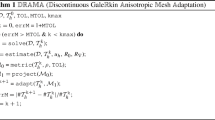Abstract
Improvements to a local modification-based anisotropic mesh adaptation procedure are presented. The first improvement focuses on control of the local operations that modify the mesh to satisfy the given anisotropic mesh metric field. The second is the parallelization of the mesh modification procedures to support effective parallel adaptive analysis. The resulting procedures are demonstrated on general curved 3D domains where the anisotropic mesh size field is defined by either an analytic expression or by an adaptive correction indicator as part of a flow solution process.












Similar content being viewed by others
Notes
The basic unit to assign the destination partition id in the mesh migration procedure which is any mesh entity not on the boundary of any higher order entities.
The scalability of a parallel program running on p processors against the program on one processor.
References
Baker TJ (1997) Mesh adaptation strategies for problems in fluid dynamics. Finite Elem Anal Des 25(3–4):243–273
Apel T, Grosman S, Jimack PK, Meyer A (2004) A new methodology for anisotropic mesh refinement based upon error gradients. Appl Numerical Math 50(3–4):329–341
Bottasso CL (2004) Anisotropic mesh adaptation by metric-driven optimization. Int J Numer Meth Eng 60(3):597–639
Frey PJ, Alauzet F (2004) Anisotropic mesh adaptation for CFD simulation. Comput Methods Appl Mech Eng (accepted)
George PL, Hecht F (1999) Non isotropic grids. In: Thompson J, Soni BK, Weatherill NP (eds) CRC Handbook of Grid Generation. CRC Press Inc., Boca Raton 20.1–20.29
Kunert G (2002) Toward anisotropic mesh construction and error estimation in the finite element method. Numerical Meth Partial Differential Equations 18:625–648
Li X, Shephard MS, Beall MW (2005) 3D anisotropic mesh adaptation using mesh modifications. Comput Methods Appl Mech Eng (in press)
Pain CC, Umpleby AP, de Oliveira CRE, Goddard AJH (2001) Tetrahedral mesh optimisation and adaptivity for steady-state and transient finite element calculations. Comput Methods Appl Mech Eng 190:3771–3796
Peraire J, Peiro J, Morgan K (1992) Adaptive remeshing for three dimensional compressible flow computation. J Comp Phys 103:269–285
Remacle JF, Li X, Shephard MS, Flaherty JE (2003) Anisotropic adaptive simulation of transient flows using discontinuous Galerkin methods. Int J Num Meth Eng (in press)
Tchon KF, Khachan M, Guibault F, Camarero R (2005) Three-dimensional anisotropic geometric metrics based on local domain curvature and thickness. CAD Comput Aided Des 37(2):173–187
Yamakaw S, Shimada K (2000) High quality anisotropic mesh generation via ellipsoial bubble packing. 9th International Meshing Roundtable
Li X, Shephard MS, Beall MW (2003) Accounting for curved domains in mesh adaptation. Int J Numer Meth Eng 58:247–276
de Cougny HL, Shephard MS (1999) Parallel refinement and coarsening of tetrahedral meshes. Int J Numer Meth Eng 46:1101–1125
Seol ES, Shephard MS (2005) Efficient distributed mesh data structure for parallel automated adaptive analysis. Eng Comput (submitted)
Seol ES, Shephard MS, Musser DR (2005) FMDB: Flexible distributed mesh database. http://www.scorec.rpi.edu/FMDB
Frey PJ, George PL (2000) Mesh generation. Application to finite elements. Hermès Science Publishing, Paris, Oxford
Beall MW, Shephard MS (1997) A general topology-based mesh data structure. Int J Numer Meth Eng 40:1573–1596
Remacle JF, Klaas O, Flaherty JE, Shephard MS (2002) A parallel algorithm oriented mesh database. Eng Comput 18:274–284
Gropp B et al (2005) The Message passing interface (MPI) standard library. Argonne National Laboratory http://www-unix.mcs.anl.gov/mpi
Loy R (200) Autopack user manual. Science Division, Argonne National Laboratory
Boman E, Devine KD, Hendrickson B et al (2001) Zoltan: a dynamic load-balancing library for parallel applications, Sandia National Labs, Zoltan’s user guide v1.23. http://www.cs.sandia.gov/zoltan
Remacle JF, Flaherty JE, Shephard MS (2003) An adaptive discontinuous Galerkin technique with an othogonal basis applied to compressible flow problems. SIAM Rev 45:55–73
Barth TJ, Jespersen DC (1989) The design and application of upwind schemes on unstructured meshes. AIAA Paper 89-0366
Krivodonova L, Xin J, Remacle JF, Chevaugeon N, Flaherty JE (2004) Shock detection and limiting with discontinuous Galerkin methods for hyperbolic conservation laws. Appl Numer Math 48:323–338
Author information
Authors and Affiliations
Corresponding author
Appendix: Analytical size field definition
Appendix: Analytical size field definition
In this section, the four analytical size fields used in Sect. 4 are described.
A planar shock
We consider the following analytical size
with h max=0.2 and the analytical metric is given by:
A cylindrical shock
The analytical size field representing a cylindrical shock of radius R=1 and axis z=0 is defined by:
with h max=0.14 and the analytical metric is given by:
where \(r=\sqrt{x^{2} + y^{2}}.\)
Two spherical shocks
We consider an analytical size field representing two spherical shocks of radius R=1 and centers (0, 0, 0) and (1, 0, 0), defined by:
with h max=0.14 and the analytical metric is given by:
where v 1=(x/r 1, y/r 1, z/r 1) with \(r_{1} = \sqrt{x^{2} + y^{2} + z^{2}},\) v 2 =((x−1)/r 2, y/r 2, z/r 2) with \(r_{2} = \sqrt{(x-1)^{2} + y^{2} + z^{2}}\) and v 3=v 1 ∧ v 2.
In parallel, we define the same metric field with the following size:
with h max=0.14.
Rights and permissions
About this article
Cite this article
Alauzet, F., Li, X., Seol, E.S. et al. Parallel anisotropic 3D mesh adaptation by mesh modification. Engineering with Computers 21, 247–258 (2006). https://doi.org/10.1007/s00366-005-0009-3
Received:
Accepted:
Published:
Issue Date:
DOI: https://doi.org/10.1007/s00366-005-0009-3




